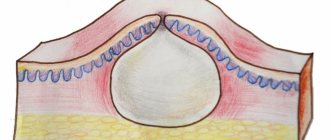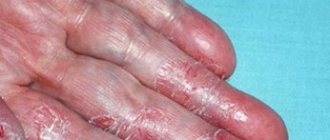Sebaceous glands located on any part of the skin can serve as a source of fatty cysts, but most often they occur in the face and scalp. Atheromas are typical for young people, mainly 20–30 years old, since at this age sebum production is most active.
The size of the cyst is constantly increasing, which is associated with the continuous production of sebum into the clogged lumen of the gland. Over time, the atheroma becomes more noticeable, and when palpated, it feels like a painless and easily removable nodule.
Considering the asymptomatic course, the main reason for contacting a doctor is a cosmetic defect, which is a visible “bump” of a fairly large diameter.
Causes
The main reasons for the development of sebaceous gland cysts are:
- swelling of the follicle caused by injury or hair removal, leading to blockage of the exit;
- injury or rupture of the sebaceous gland, leading to the formation of a subcutaneous cyst;
- acne;
- increased sweating;
- heredity;
- increased testosterone levels;
- seborrhea;
- puberty, accompanied by increased activity of the sebaceous glands.
Symptoms of atheroma in adults
Atheroma has clear boundaries, dense and elastic to the touch. It is located directly under the skin and moves freely under it if you gently press it with your finger. The color of the skin in the area with atheroma is usually not changed, but with rapid growth it may turn red or become covered with ulcers. Sometimes an enlarged duct of the sebaceous gland is noticeable on the atheroma, and if the atheroma communicates with the skin, then through this duct cheesy white, grayish or yellowish masses with an unpleasant odor can be separated - sebum. The atheroma itself is absolutely painless, and if it is small in size and does not increase, it does not cause any physical discomfort, although from the outside it may look like a significant cosmetic defect.
Methods for removing atheroma
Removal of atheroma with laser and radioknife
Treatment of sebaceous gland cysts with a laser is characterized by bloodlessness and the absence of visually noticeable traces of the intervention, therefore this method is often used when removing atheroma on the face. It is recommended in cases where the size of the tumor does not exceed 1 cm. After laser exposure, there are no visible traces - scars, cicatrices - at the site of removal.
Radio wave removal of atheroma at the Miracle Doctor clinic is carried out using a specialized Surgitron device. High-frequency exposure to a radioknife leads to evaporation of the cyst capsule along with its lipid contents. Removal is carried out on any part of the body in cases where the linear dimensions of the wen do not exceed 2 cm.
Surgery to remove atheroma
Surgical removal of atheroma in Moscow at the Miracle Doctor clinic is performed on an outpatient basis under local anesthesia through a minor surgical operation lasting 15-25 minutes. The total time spent with a doctor, including preparatory procedures, surgery, and bandaging, does not exceed 30 minutes in uncomplicated cases.
In the case of a well-localized uninfected atheroma, the surgeon excises the skin and peels out the walls of the capsule along with the contents.
In case of suppuration of the cyst, the doctor removes the capsule within healthy tissues with careful sanitation of the resulting cavity.
Suppuration of atheroma with the formation of inflammation and abscess requires drainage of purulent contents followed by the use of antibacterial drugs. Then, in order to avoid recurrence of inflammation, after some time the patient is sent for a second operation to completely remove the remnants of the atheroma.
The cost of removing a wen depends on the size, the presence of complications, the chosen method of removal, and the individual characteristics of regeneration in the patient’s body.
Cost of treatment of atheroma
The cost of the operation depends on the size of the tumor; more detailed information can be found by calling.
Causes of atheroma
There are true and false atheromas.
The true form occurs when there is an abnormality of the skin as a result of heredity. The rudiments of the sebaceous glands, which should be on the surface of the skin, are located deeper and do not come to the surface.
- False atheroma develops as a result of blockage of the excretory duct of the gland, which leads to the accumulation of secretions in a gradually enlarging cavity. The cause of blockage may be metabolic and hormonal disorders in the body, hyperhidrosis, neglect of personal hygiene, use of low-quality cosmetics, etc. In addition, atheroma can appear when the hair follicle is damaged or the sebaceous gland ruptures due to an inflammatory process. Unfavorable risk factors that increase the risk of tumor development include acne and skin damage.
Symptoms of atheroma
The tumor has clear boundaries; when palpated, it is soft and mobile. In the center of the formation, you can notice a blocked sebaceous duct; often whitish contents are released from it. The tumor, in addition to psychological discomfort, can cause pain if it is in contact with clothing. An atheroma that has increased in size can compress nearby tissues and vessels.
Significant discomfort occurs when there is a complication, the signs of which are swelling around the tumor, pain when pressed, and redness. An attempt to get rid of the formation on your own is fraught with the development of an abscess, which is accompanied by an increase in body temperature, swelling, redness, and then the opening of the abscess. After a breakthrough, fistulas may appear; if the capsule is preserved, relapses will occur in the future.
Diagnosis of atheroma
The diagnosis can be made based on examination, but atheroma must be differentiated from fibroma, lipoma, dermoid cyst, or malignant soft tissue tumors.
Complications
Delaying the treatment of atheroma is fraught with suppuration of the cyst, when its capsule grows in size, swells, turns red, the skin over it becomes tense and causes pain in the patient. Independent attempts to squeeze out the contents of the formation often end with the transition of the disease to a new stage - abscessing atheroma, accompanied by swelling of nearby tissues and lymph nodes, severe pain, and general intoxication of the body. The most unfavorable outcome of the developing situation may be the entry of infection from the purulent sac into the patient’s circulatory system, which can cause sepsis.
If you are looking for where to remove a wen, contact the surgical department of the Miracle Doctor clinic. Experienced surgeons will diagnose and treat using the optimal method.
Make an appointment on the clinic’s website in the “Schedule” section or by calling the hotline.
Distinctive features of atheroma on the leg
In most cases, the location of atheroma on the leg is the thigh, and more often the back of the lower leg. Neoplasms can be single, but they can also appear in large numbers.
The size of the tumor may vary, and the color usually does not differ from the natural color of the skin. The neoplasm always protrudes slightly above the skin, and its consistency is soft and mobile. The reason for this is the contents of the tumor, which includes sebum and epithelial cells.
Often, atheromas on the legs become carriers of infections, for which the environment established inside the tumor is ideally favorable. This leads to inflammation, suppuration of atheromas, increased temperature and painful sensations.
What symptoms do you see a surgeon for:
- Presence of hernial protrusion
- Daggering pains in the abdomen
- Bloating
- Pain in the right hypochondrium
- Bitterness in the mouth
- Nausea
- Presence of neoplasms on the skin
- Swelling and redness of the skin
- Bone fractures and bruises
- Wounds of any location
- Vomit
- Enlarged and painful lymph nodes
How is the operation performed?
If the operation is performed as planned, then hospitalization is not required. In order to remove atheroma, the following steps are taken:
1. Anesthesia is applied.
2. The skin flap to which the atheroma is fused is excised.
3. The capsule is isolated and excised.
4. Stitches are applied.
The entire operation takes about 40 minutes and leaves no noticeable cosmetic defects.
If necessary, atheroma can also be removed in our hospital, which affects the price of the service.
After operation
Rehabilitation after removal of atheroma is not required and the patient can leave the center 3 hours after its completion. In the next 2-3 days, it is recommended to carefully monitor the condition of the wound and consult a doctor to change dressings. Follow-up examinations are usually scheduled after the first and fourth weeks.
FAQ
— Can atheroma develop again?
Yes, but not in the same place as the removed one, since the capsule is also removed during therapy.
— Is preliminary research necessary?
Yes, because it allows you to accurately diagnose the patient. In some cases, the development of atheroma is accompanied, for example, by atherocystic cancer.
— At what age can a child have atheroma removed?
From 3 years old.
Calculation of the cost of atheroma removal on an outpatient basis:
| Manipulation name | Cost, rub |
| Removal of benign tumors of the trunk, limbs, small sizes | 5000 |
| Local anesthesia for minor surgical interventions | 1750 |
| Histological examination | 2020 |
| TOTAL: | 8770 |
Diagnostics and laser treatment
If you notice a tumor on your ear, face, head or body, make an appointment with a specialist at our Center. The doctor will carefully examine and palpate the lump - in most cases this is enough for diagnosis. If necessary, a histological examination is performed. When a diagnosis of atheroma is made, treatment will be prescribed in accordance with the characteristics of the formation, location, and depth.
In most cases, laser removal of atheroma, which will be offered to you in our Center, is the most effective. If the size of the compaction does not exceed 5 mm, it is evaporated with a laser to the boundaries of healthy tissue. After this, a coagulation crust forms, which disappears after a maximum of 2 weeks.
If the formation is more voluminous or inflamed, it is first opened with a scalpel, the purulent contents are removed with tampons, then the cavity is treated with a laser beam. The resulting wound is sutured, leaving rubber drainage if necessary. The sutures are removed after 8-12 days. A small scar remains at the site of the operation after atheroma. Over time, it becomes unnoticeable.
Suppuration of atheroma, what causes inflammation?
The only reason for atheroma suppuration is the entry of microorganisms into the atheroma capsule. They penetrate there, most often during independent attempts to get rid of atheroma or during injuries. Atheromas in the facial area are often mistaken for small pimples and when you try to squeeze them out, pathogenic bacteria penetrate inside. The inflammatory process in atheroma manifests itself as pain in the area where the process is localized, changes in the color of the skin and the size of the formation. Very often, a suppurating atheroma can rupture on its own; in such cases, it is necessary to apply a bandage to the damaged area and immediately seek medical help.
Removal of inflamed atheroma
If pus appears in the atheroma, you should immediately consult a doctor. He will diagnose it and prescribe the correct treatment. Basically, the inflamed cyst is removed surgically. During this surgical procedure, the fatty content of the atheroma and its capsule are removed. It is also necessary to remember that if the atheroma becomes inflamed, it cannot be removed immediately in order to reduce the risk of pus breaking through the skin.
Treatment of atheroma with inflammation is quite complex. First, the surgeon opens the tumor and removes its contents. Then he rinses the cavity, cleared of pus, with antiseptic drugs. Afterwards, drainage is installed, with the help of which the rotting products will be removed, and the cavity will be washed with antiseptics. A special sterile bandage with medicinal ointment is applied to the affected area. If the suppuration of the cyst is severe, the attending physician may prescribe antibiotics.
The most important task for the surgical treatment method is to remove the atheroma shell itself in order to avoid the development of relapse. That is why, after a certain amount of time, it will be necessary to repeat the procedure to completely remove the capsule.
When atheroma becomes inflamed, the main thing is to begin treatment immediately. To make a correct diagnosis and prescribe treatment, you must consult a doctor. The clinic provides the services of highly qualified surgical specialists who will help get rid of such problems as inflammation of atheroma.
Diagnostic methods in surgery:
- Doppler in surgery
- Colonoscopy
- Angiography
- CT scan
- Gastroscopy
- MRI
- Abdominal ultrasound
- X-ray
- Endoscopy
Prices:
| Code | Name of service | Prices |
| 1 | Initial appointment | 1200 |
| 2 | Repeated appointment | 900 |
| 3 | Calling a surgeon to your home | 3500 |
| 4 | Abdominal ultrasound | 2200 |
| 5 | Ultrasound of veins and vessels | 2400 |
| 6 | Doppler 2-3 trimester | 1200 |
| 7 | Rectoscopy | 1500 |
Removal - only by a specialist
Important! If you are diagnosed with atheroma, treatment at home cannot be carried out. Even in the absence of pain and other unpleasant symptoms, the tumor should be shown to a doctor.
There is no need to be afraid of the excision procedure. Unlike the surgical method, laser removal of atheroma:
- takes little time;
- not accompanied by bleeding;
- reduces the possibility of relapse.
When combining both methods, all these advantages are preserved.
We invite you to our Center for consultation regarding the appearance of a skin tumor. Here you will be accurately diagnosed and offered to painlessly and quickly remove the atheroma in the most effective way - using a laser.
Prevention
After the operation, you must carefully follow all the doctor’s instructions :
- change the dressings covering the open wound daily;
- Take antihistamines, painkillers and antibiotics prescribed by your doctor.
Depending on the size of the tumor and the absence or presence of an inflammatory process, the presence of a scar after surgery can be predicted.
After the wound begins to heal and its edges are stitched (or glued with special medical glue), it is necessary to use a plaster that protects the wound from germs and pathogenic microorganisms.
In some cases that have deviations from the normal healing process, the surgeon carries out an individual treatment procedure for such a patient.
Important : when removing a suppurating cyst, as well as in the case of incomplete enucleation of its capsule, relapses of atheroma are possible - its repeated formation and growth.
Can atheroma resolve on its own?
In rare cases, the neoplasm may disappear without surgical intervention, but you should not hope that the atheroma will resolve on its own. If your doctor advises you to remove the tumor, you should listen to him. A tumor under the skin can be removed in one of three ways: radio wave, surgical excision or laser. Getting rid of a tumor is easy: to reduce the risk of skin damage and scarring, it is better to choose a laser or radio wave method. Relapse after treatment is extremely unlikely - the tumor reoccurs in only 3% of cases.
Without surgery
This method of therapy is possible with the help of traditional medicine advice. Most often, Vishnevsky ointment or homemade garlic ointment with vegetable oil is used for this. Such products must be applied to the neoplasm or rubbed into its surface, secured with a band-aid. Such manipulations must be carried out several times a day, preferably at night.
Treatment of atheroma at home with the help of Ichthyol ointment or Liniment is necessary at the very beginning of the process of wen formation. If the growth opens on its own, it is necessary to thoroughly clean its cavity from the contents, disinfect the wound and the skin around it, using wound-healing agents.
Attention : when choosing medications for the treatment of atheroma on your own, you must take into account possible contraindications and side effects. In addition, therapy for a wen is more successful only at the very beginning of its development; an advanced and expanded tumor will most likely require surgical removal.
The appearance of atheroma, why does this happen?
Among the causes of atheroma, there are several main ones:
- insufficient skin care - with prolonged accumulation of dirt particles mixed with sweat in the thickness of the skin, blockage of the glandular duct is possible, which leads to the formation of atheroma;
- systematic injury to the skin - causes detachment of skin cells that prevent the outflow of glandular secretions;
- hormonal imbalance – this especially applies to sex hormones;
- excessive sweating;
- poor environmental situation.
Rice. 3. Squeezing out atheroma is not recommended.
Causes of atheroma
The only cause of the disease is blockage of the sebaceous gland on the face due to increased density or impaired outflow of sebum. Different conditions can provoke this process. Such factors are divided into internal and external, the latter including:
- bad ecology;
- heat;
- work in highly polluted conditions;
- use of oil-based cosmetics.
Internal causes of atheroma are:
- oily seborrhea;
- bacterial growth on the face (insufficient skin hygiene);
- hyperhidrosis;
- heredity;
- acne;
- impaired metabolic processes;
- hormone imbalance.
In men, a factor provoking the disease may be an increased amount of testosterone produced and irregular shaving of the beard/mustache. In newborn babies, a cyst on the cheek, as a rule, indicates the presence of maternal hormones. Doctors often associate the appearance of oily warts with the effect of cosmetics with a thick texture on the skin (as a rule, these are oil-based products that clog pores).
Atheroma in a child
Benign formations on the face are more common during puberty, when adolescents begin puberty. However, experts sometimes diagnose a tumor in small children, including newborns. Atheroma in a child of this age is provoked by the accumulation of fatty secretions, as a result of which the gland duct is clogged. Possible causes of pathology in children may be:
- increased sweating;
- insufficient skin hygiene;
- wearing clothes that are too warm (overheating of the body) or things made of synthetic materials;
- changes at the hormonal level.
Atheroma can occur due to improper functioning of the endocrine system. In addition, children with excess weight, acne and acne are predisposed to pathology. The disease in a newborn indicates defects during the intrauterine formation of the epidermis. The reason for this anomaly is unknown, but some experts associate it with the diet and lifestyle of the woman bearing the fetus.
Prevention of complications.
It is important not to delay contacting a doctor if any skin swelling is detected. Only an experienced specialist can correctly diagnose the type of neoplasm and prescribe appropriate treatment. It is possible to stop the manifestations of the disease using conservative methods only at the earliest stage, before an abscess has formed.
The video on this page will tell you what inflamed atheroma sometimes leads to. The consequences are very serious. The only way to treat inflamed purulent atheroma is surgery, preferably using a laser. Come to us!










